Characteristics
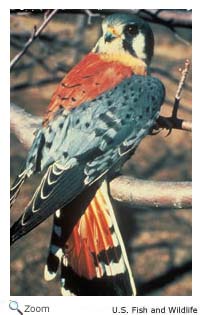 The American kestrel is the smallest North American falcon. It is 9-12 inches in length with a wingspan of 21 inches. It has a rusty tail and back and two vertical black stripes on its face. It has a short, hooked bill; white cheeks; a long tail and long, pointed wings. The male has slate-gray wings and a spotted breast and belly. The female has rusty wings and streaks on her breast. The American kestrel is also known as the sparrow hawk. The American kestrel is the smallest North American falcon. It is 9-12 inches in length with a wingspan of 21 inches. It has a rusty tail and back and two vertical black stripes on its face. It has a short, hooked bill; white cheeks; a long tail and long, pointed wings. The male has slate-gray wings and a spotted breast and belly. The female has rusty wings and streaks on her breast. The American kestrel is also known as the sparrow hawk.
Range
 The American kestrel
can be found throughout North and South America from near the tree-line in Alaska and Canada and south to Tierra del Fuego. The American kestrel
can be found throughout North and South America from near the tree-line in Alaska and Canada and south to Tierra del Fuego.
Habitat
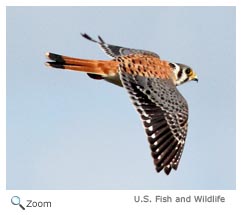 The American kestrel can be found in almost any habitat that has open areas for hunting and tall places for it to perch. The American kestrel is the only North American falcon or hawk that nests in cavities. It makes its nest in tree cavities, under eaves, in woodpecker holes and in nesting boxes. The American kestrel can be found in almost any habitat that has open areas for hunting and tall places for it to perch. The American kestrel is the only North American falcon or hawk that nests in cavities. It makes its nest in tree cavities, under eaves, in woodpecker holes and in nesting boxes.
|
| |
Diet
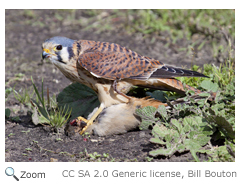 The American kestrel eats grasshoppers, crickets, grasshoppers, beetles, dragonflies, butterflies, small mammals, sparrows and other small birds, reptiles and amphibians. It perches on trees and telephone poles looking for prey. It often hovers over its prey and then drops down on it. Unlike other falcons, the American kestrel often catches its prey on the ground. The American kestrel eats grasshoppers, crickets, grasshoppers, beetles, dragonflies, butterflies, small mammals, sparrows and other small birds, reptiles and amphibians. It perches on trees and telephone poles looking for prey. It often hovers over its prey and then drops down on it. Unlike other falcons, the American kestrel often catches its prey on the ground.
Life Cycle
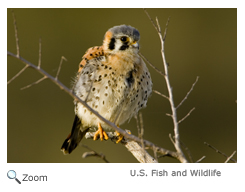 The American kestrel mates from March to April to early June, depending on its geographic location. The American kestrel mates from March to April to early June, depending on its geographic location.
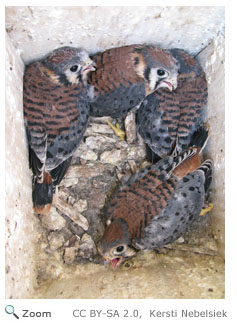 The female American kestrel may mate with two or three males before settling on a single mate. She lays three to seven eggs. The female does most of the incubation. The eggs hatch in about a month. At first, the male brings food to the female who then feeds the chicks. Later, the male will also feed the chicks. The chicks fledge in about 30 days but stay with their parents for a few weeks after fledging. The female American kestrel may mate with two or three males before settling on a single mate. She lays three to seven eggs. The female does most of the incubation. The eggs hatch in about a month. At first, the male brings food to the female who then feeds the chicks. Later, the male will also feed the chicks. The chicks fledge in about 30 days but stay with their parents for a few weeks after fledging.
Behavior
Except for during the mating season, the American kestrel is a solitary animal.
|